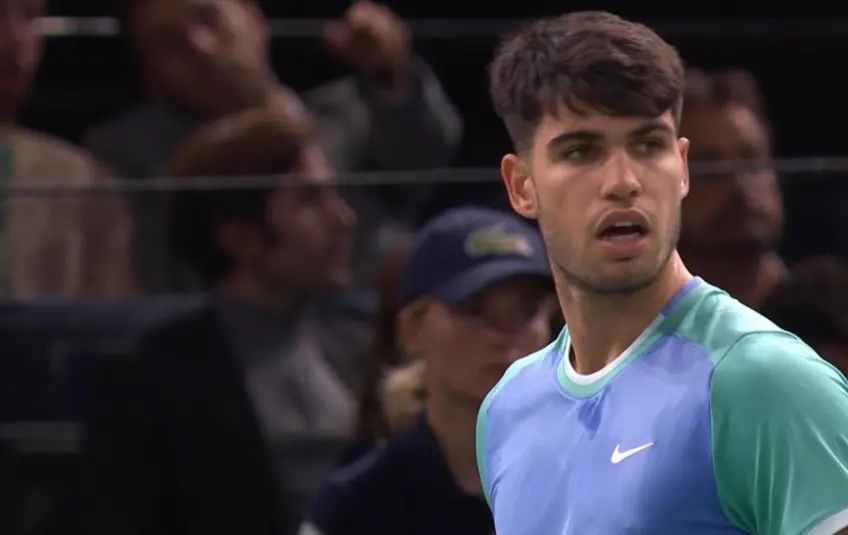
Carlos Alcaraz’s run at the 2024 Paris Rolex Masters came to an end in the round of 16, as Frenchman Ugo Humbert defeated him in a close match that ended 6-1, 3-6, 7-5. In the press conference following his exit, the young Spaniard openly expressed his thoughts on the unusually fast court conditions at Paris-Bercy, a topic that has sparked conversation throughout the tournament.
“I could have played better; I gave it my all,” Alcaraz remarked with characteristic honesty. “I fought until the last point. I have to congratulate Ugo. He played very well, he had a great performance. It’s fantastic. He plays at a really high level. And I think in Paris, he’s even higher. So congratulations to him,” he added, showing respect for his opponent’s strong play. However, Alcaraz quickly shifted to the topic of the court’s pace, noting how it affected his ability to find rhythm.
“It’s very difficult to play in these conditions,” Alcaraz said, describing the challenges he encountered in trying to play his best tennis. “I wouldn’t say the indoor courts are the problem. I would say the problem is this court. I don’t want to make excuses because Ugo deserved to win, but for example, I played in the Davis Cup indoors, and the courts were much slower than this one. I played the first match of the tournament, and from the statistics, it turned out that this is the fastest court in the Masters 1000. It is probably the fastest in the last ten years in this tournament.”
Alcaraz’s observations bring attention to the changing nature of surfaces in the tennis world, with speed fluctuations now becoming a point of debate. Alcaraz, who is known for his ability to adapt to different surfaces, acknowledged that he should have arrived earlier to acclimatize to the unique conditions in Paris. “I probably had to come earlier to adapt to these conditions, but I didn’t. But in the end, honestly, all I can say is that I don’t understand why it was done,” he concluded, expressing bewilderment over why the Paris-Bercy court surface had been altered to this extent.
In recent years, there has been growing dialogue about court speed and its impact on play styles. Alcaraz’s observations point to a larger trend in tennis where surfaces are continuously adjusted to suit various tournament objectives. Faster surfaces, such as those at the Paris Rolex Masters and the Cincinnati Open, are becoming less common, and they present unique challenges for baseline players accustomed to longer rallies. Alcaraz’s comment that “the ball slides as soon as it bounces” underlines the challenges he faced, highlighting how players must quickly adapt their timing and shot selection on such courts.
The fast conditions in Paris-Bercy have stirred a broader conversation within the tennis community about whether such adjustments are beneficial for the sport. While Alcaraz voiced frustration, some argue that fast surfaces are essential to ensure diversity in playing conditions. “A complete tennis player can be seen on all surfaces, in all conditions,” one journalist commented, referencing players like Rafael Nadal who have adapted their styles across diverse surfaces and conditions throughout their careers. Nadal, for example, reached the final of the 2017 Australian Open on a fast, renovated surface, proving his versatility against longtime rival Roger Federer in a memorable encounter.
Others in the tennis world echo Alcaraz’s concerns, as these faster surfaces demand different physical and tactical adjustments. Alcaraz himself has struggled on quick courts this season; at the Cincinnati Open, he faced an unexpected defeat by Gael Monfils and similarly commented on the challenging pace of play there. After an early-round victory in Paris against Chilean Nicolas Jarry, Alcaraz again addressed the difficulties posed by the Paris-Bercy court, noting, “Surfaces faster than those of Cincinnati? The truth is that my feeling was that this surface was the second fastest, behind Cincinnati.” This statement from Alcaraz points to a possible trend in which certain tournaments, particularly the hard-court Masters events, are opting for faster surfaces to diversify match styles.
Alcaraz’s critique is not an isolated one. Throughout the year, he has spoken on the impact of fast courts, underscoring his preference for a more moderate pace that allows players to rally and construct points. The Spaniard is known for his baseline consistency and ability to engage in lengthy rallies, skills that are difficult to showcase on exceptionally fast surfaces. When facing opponents like Humbert, who plays an aggressive, flat-hitting game, Alcaraz finds it challenging to establish control, as the rapid pace limits his chances to settle into points.
Ultimately, the Paris-Bercy court debate touches on the larger question of what makes tennis engaging for both players and fans. Faster courts often yield shorter rallies and quicker points, which can create excitement but may detract from the extended baseline exchanges that many fans love to see. However, for players with a strong net game or a preference for serve-and-volley tactics, these surfaces present an advantage, adding an element of variety that is sometimes lacking in modern tennis.
For now, Alcaraz must continue adapting to a landscape where court speeds fluctuate, a reality that demands versatility and mental resilience. As he continues to evolve his game, finding ways to thrive on all surfaces will be crucial. Despite the challenges posed by these fast courts, Alcaraz remains focused on his long-term development, acknowledging that every match, regardless of conditions, is an opportunity to improve.
The 2024 Paris Rolex Masters may have posed difficulties for the young Spaniard, but with his talent and adaptability, Alcaraz is poised to meet these challenges head-on in future tournaments.
Leave a Reply